Catch one of the most active small bodies in the solar system during a rare superoutburst.
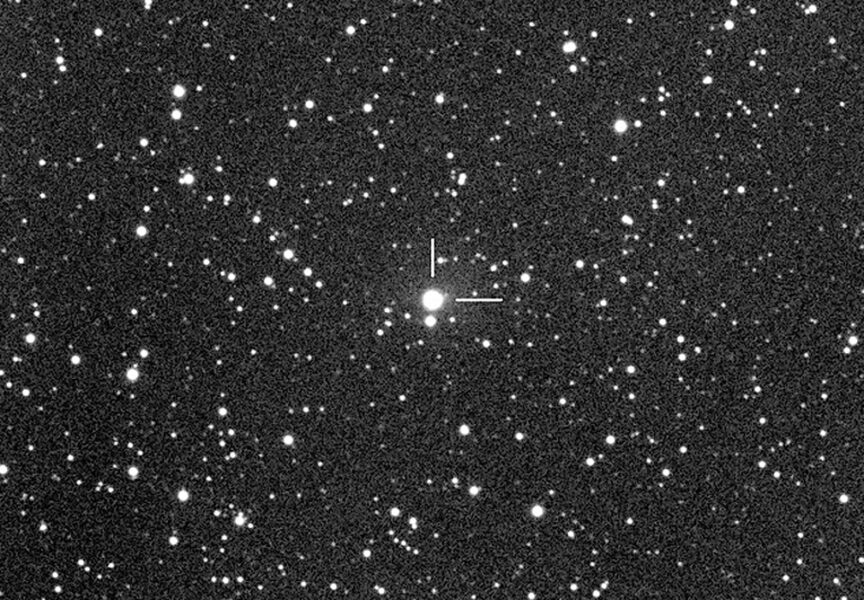
Martin Mobberley
A comet infamous for its explosive personality has been in near-continuous outburst since September 25th. The brightness of Comet 29P/Schwassmann-Wachmann is steadily rising, and it now appears as a tiny, 11th-magnitude object easily visible in 8-inch and larger telescopes. If you've never seen a comet masquerade as a star-like planetary nebula, don't pass up the chance — look soon. As the outburst evolves the comet's coma will expand but also fade.
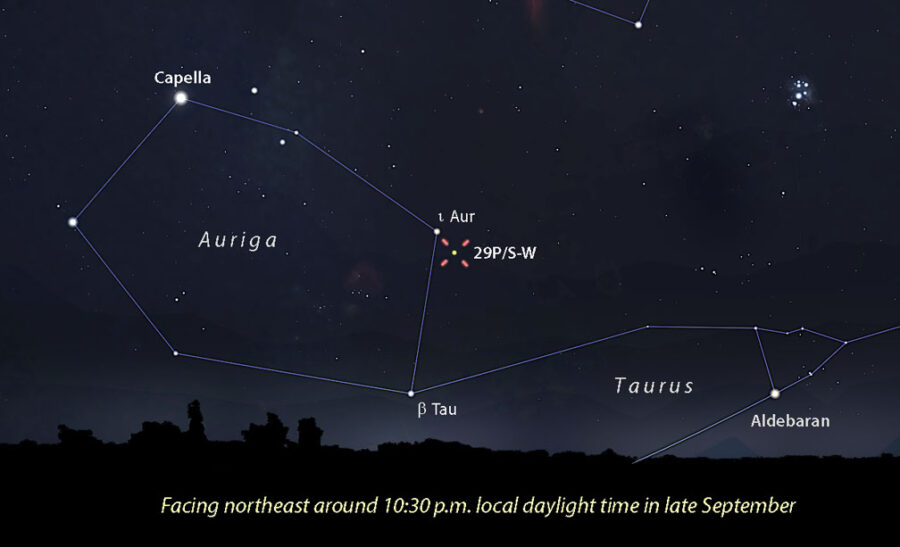
Stellarium
Timing and location couldn't be better, with the comet just 1.3° south-southeast of the easy, naked-eye star Iota (ι) Aurigae and standing at the threshold of a copious viewing window. Best viewing starts around 10:30 p.m. local daylight time and lasts till dawn. I caught 29P on Tuesday night, September 28th at 10:15 p.m. CDT, 45 minutes before the last-quarter Moon rose.
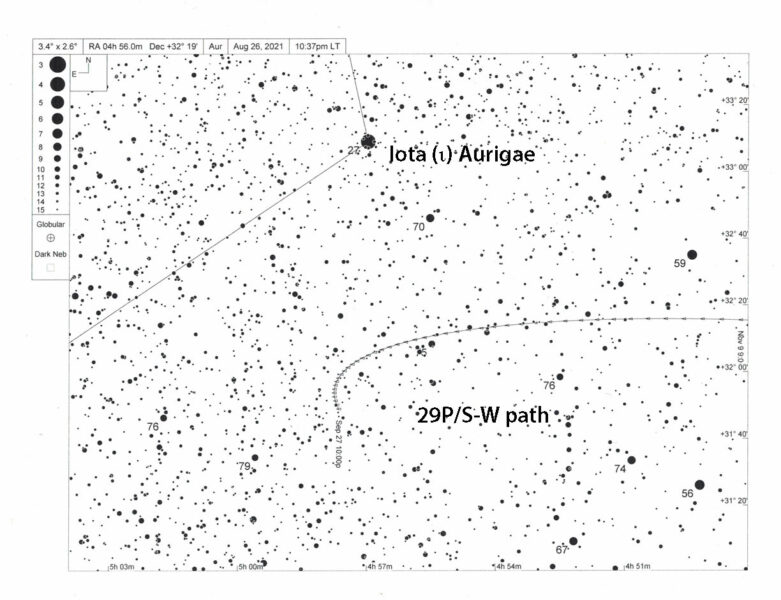
MegaStar, used with permission
Although just 12° altitude, I spotted the suspected comet in my 15-inch Dob even at the lowest magnification of 64×. At a casual glance, it looked exactly like a star, but with averted vision I could see a small, faint coma enrobing the bright false nucleus. Lucky or not, 29P was involved with a 13th-magnitude star some 12″ to its east at the time. When I looked again just before moonrise, it had parted company.
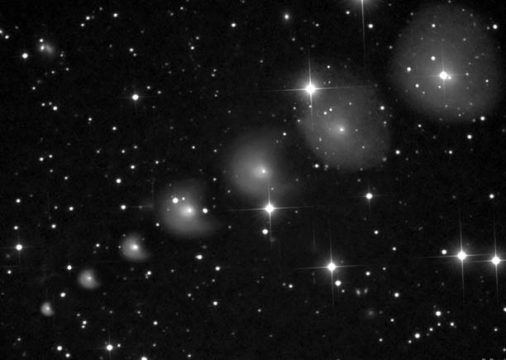
Damian Peach
Due to low altitude, I couldn't make out more detail, just a super-compact, bright coma with a degree of condensation (DC) of 8 on a scale of 0 to 9, from least to most concentrated. I'm as eager as you are to get the scope out again for another look. The comet may continue to flare and brighten or begin its inevitable dimming. To see night-to-night changes in a celestial object is one of the reasons comets are so fun to observe.
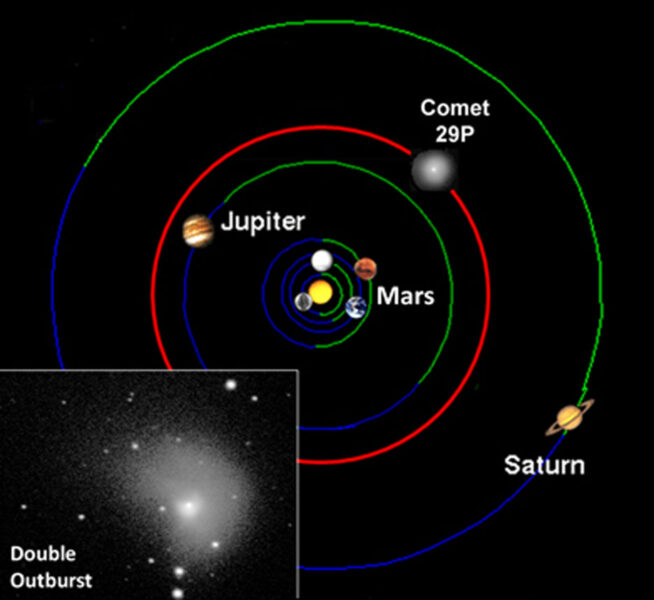
Courtesy of Richard Miles
Many comets have outbursts, but 29P is unique because it averages 7.3 outbursts a year! Typically, two or three per apparition are visible in amateur telescopes. Normally a 16th-magnitude object, a blow-up can vault this comet from obscurity to as bright as 10th magnitude. It orbits a fair bit beyond Jupiter with a period of 14.7 years, and as comets go, it's enormous with a diameter of 60.4 ± 7.4 kilometers. Frankly, to see any comet at such an incredible distance is not only amazing but an indication of just how powerful the current outburst must be.
Richard Miles, with the British Astronomical Association (BAA), is the project lead on the MISSION 29P, a clearinghouse devoted to news and observations of the comet with the hope of better understanding the underlying cause of its tumultuous outbursts. Miles suspects that the object may have undergone four successive outbursts, with "each subsequent event triggering the next" during the current flare-up. Another good resource for current comet happenings is the Comets Mailing List.
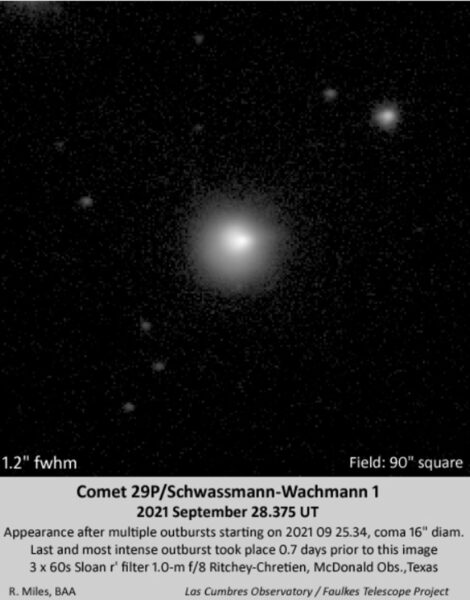
Richard Miles
Water ice, an important volatile that drives activity in many comets, is virtually inert at 29P's distance. Instead, vaporizing carbon monoxide ice appears to be the key driver of its regular outbursts. Based on data obtained largely by amateur astronomers, Miles describes the outbursts as cryovolcanoes that erupt explosively after carbon monoxide and methane, under pressure beneath the comet's crust melt, mix and release energy. Solar heating causes the crust above these spots to give way, explosively releasing gases along with up to a million tons of dust and debris at a shot. Think of popping the cork on a bottle of champagne. Because 29P is a large comet, its gravity temporarily reseals the "wound" until another cycle begins.
As described in the September 2021 issue of Sky & Telescope magazine, there's currently a multi-wavelength campaign to observe this comet. You're encouraged to share your observations at the 29P/ S-W 1 Observations page.
Wishing you clear skies so you can witness 29P's delightful and instructive volatility!
 10
10









Comments
OwlEye
October 4, 2021 at 12:19 pm
Hi Bob,
After a slow-moving low passed to our east yesterday, we finally had some clear weather last night and this morning. I had planned to get up at 5:20 CDT to have a look at 29P, but woke up an hour earlier. It was well that I did, because the infrared satellite image showed clouds forming just NE of my observing location, moving slowly SW. The 12.5-inch was already set up, and it only took a few seconds star-hopping southward from Hassaleh (Iota Aurigae) to spot the comet, which resembled a featureless planetary nebula. Two handy stars in the 79 X, 0.9 degree field of the 40 mm SWAN eyepiece made nice comparisons when thrown out of focus to the same size of the comet, yielding a magnitude estimate of 10.7. The degree of coma condensation was about 1 or 2, with a diameter of ~ 1.5 arcminutes.
Clouds completely covered Auriga by 5:30, when I had originally planned to observe.
DZ
You must be logged in to post a comment.
Bob KingPost Author
October 5, 2021 at 11:18 am
Thank you, Doug, for sharing your observation of this unique comet. Based on your report, it's clear that the coma is expanding.
You must be logged in to post a comment.
OwlEye
October 12, 2021 at 12:20 pm
Hi Bob,
Thanks for putting me on to the angle tool in Stellarium. It turns out that the approximate diameter of the coma in my scope on the morning of Oct. 4th was not 1.5 arcminutes, but 45 arcseconds.
This morning I finally had a chance to have another look between passing clouds, and the comet was much harder to see because it had more than doubled in size (now ~1.6 arcminutes), while the magnitude remained at ~ 10.7. DC of perhaps 2 to 3 in the 12.5-inch at 99 X.
Watching this comet grow in size as it has during this outburst period has reminded me of 17P/Holmes' incredible rise of nearly 13 magnitudes in less than one days time nearly fourteen years ago! And you well know - I just read your confirmation observations from the night it went off on the cometography website.
You must be logged in to post a comment.
Bob KingPost Author
October 12, 2021 at 11:18 pm
Hi Doug,
Very glad Stellarium's working for you. Oh gosh, I'll never forget the 17P/Holmes outburst. One of the most remarkable things I've every seen in my observing career.
You must be logged in to post a comment.
Dave Mitsky
October 4, 2021 at 10:57 pm
I observed Comet 29P/Schwassmann-Wachmann on Friday night/Saturday morning using the Naylor Observatory's 17" f/15 classical Cassegrain at 116, 144, 170, 216, and 259x. I preferred the views at 216 and 259x. The conditions were quite good; otherwise, I probably wouldn't have been successful in spotting the comet.
Comet 29P/Schwassmann-Wachmann's coma was very small and rather faint. It resembled a small planetary nebula with a diameter of perhaps an arc minute or so.
You must be logged in to post a comment.
Bob KingPost Author
October 5, 2021 at 11:16 am
Thanks, Dave, for your observation. Yes, it's quite small and has also reminded me of a planetary nebula.
You must be logged in to post a comment.
OwlEye
October 9, 2021 at 7:42 pm
Hello Dave,
I was intrigued by this 17" instrument you mention, and looked up Naylor Observatory online. Found a Wikipedia entry for it. You all have quite the array of instruments (including a 12.5-inch Cave Astrola - WOW). Who made the optics and mounting for this behemoth 17" ?
I looked at the light pollution map for Lewisberry, and it is just as good (or bad, depending on how you choose to look at it!) as my location in eastern Kansas. Your lowest power view at 116 X - any chance was that with a 56 mm, 2" Meade eyepiece, or a 55 mm Televue ?
Regards,
DZ
You must be logged in to post a comment.
SNH
October 11, 2021 at 8:51 am
Thanks for the heads up, Bob. I went after four comets yesterday morning. 29P/Schwassmann-Wachmann was the brightest and easiest to find being just off of Iota Aur. In my 10", it looked like a missing globular cluster (sorry nearby Pal 2!) with its “large” (for being over 5 AU away) coma and smooth overall brightness. It was the second time I’d ever seen ol’ 29P and was amazed that it was so bright I could see it in my 8x56 binoculars…incredible!
I also saw comet C/2019 L3 (ATLAS) with 8x56 binoculars, 67P/Churyumov-Gerasimenko with 12x60 binoculars, and 4P/Faye with my 130mm reflector. I tried and failed to bag C/2021 A1 (Leonard), though.
Scott
You must be logged in to post a comment.
SNH
October 12, 2021 at 3:23 pm
YESSSSSS! I saw C/2021 A1 (Leonard) this morning because it was so clear after a minor cold-front moved through!! It was around magnitude +12.0 - 12.5 like predicted, I'd say. It was small but had just enough central brightening that I could see it in my 5.1-inch at 59x after spotting it in my 10-inch at 117x. I wonder if anyone else has seen it visually?
Scott
You must be logged in to post a comment.
Bob KingPost Author
October 12, 2021 at 11:16 pm
Hi SNH,
So nice to hear this — and with a 5.1-inch no less! Good work! I've been trying for over a week to see it but clouds every morning. Friday looks promising. There have been other visual sightings in the same magnitude range. See this site: https://cobs.si/. Your optimistic report is much appreciated.
You must be logged in to post a comment.
You must be logged in to post a comment.